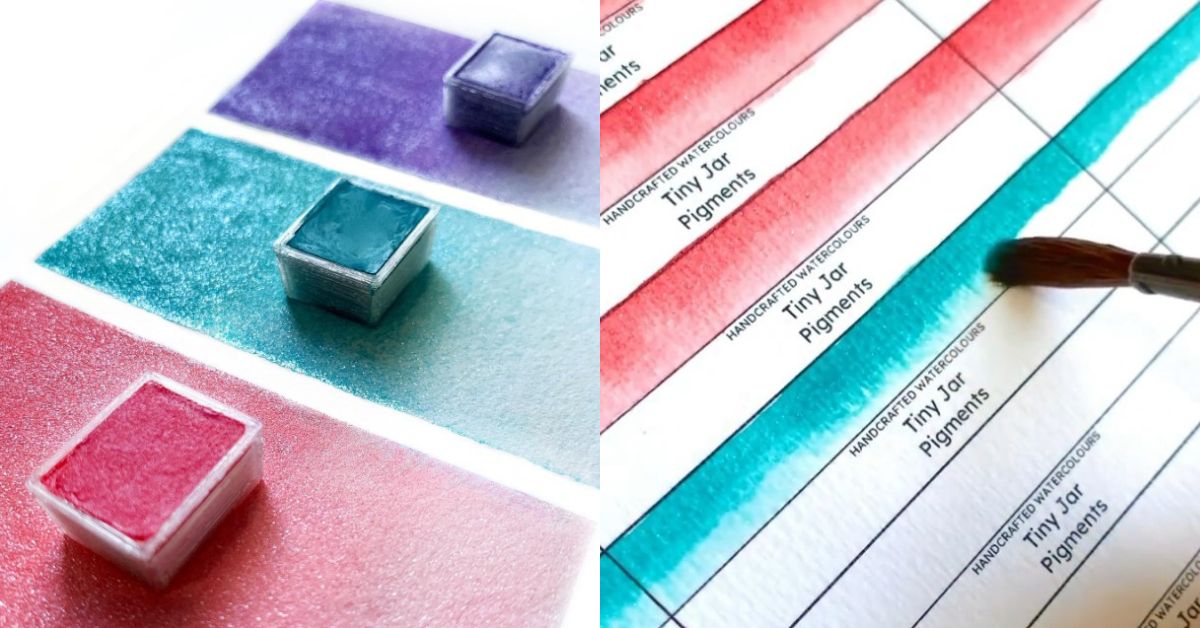[Parts of this story were taken from a video interview we did with the founder in December 2021.]
Van is a watercolour hoarder, and she doesn’t feel bad about it. In fact, she’s proud of it.
After all, it’s a habit that enables her to sustain and develop her small business, Tiny Jar Pigments.
A year ago, she had over 200 different kinds of pigments, maybe more, she mused. Some were sold in sets, which made it hard to truly keep count.
With all the investment in her pigment collection, it’s natural to assume that art is the Penangite’s full-time job.
Turns out, though, she’s actually working in the medical field, and her side hustle making unique watercolours at Tiny Jar Pigments was something she only got into during the pandemic.
She finds lots of satisfaction in her full-time job, but acknowledged that it’s very stressful and demanding.
Thus, a decade ago, she turned to art as an escape after a long day of work, and has never looked back since.
She began with collecting watercolours, until one day when she realised that she could actually make her own.
Today, she runs Tiny Jar Pigments from home as a one-woman show, creating handcrafted artisanal watercolours from scratch.
Making paints from pigments
Van’s focus with Tiny Jar Pigments is creating highly pigmented granulating watercolour paints. Briefly, watercolours can be granulating or non-granulating paints.
Granulating paints are made of denser pigments, which will be deposited on a paper’s grooves instead of settling evenly on a painted surface. This creates a more textured look, usually described as speckly or mottled.

According to Van, these paints are great for landscape paintings or special effects.
While one might think that making paints seems fairly straightforward—blend some pigment with a special binding liquid and tadah! you have paint—it’s the patience that one must practise throughout which makes it difficult.
Depending on the type of pigment and humidity, Van shared that it can take three to four weeks to develop a single colour.
The process involves adding dry pigments on a glass palette, adding gum arabic (a binder that increases colour vibrancy and extends the drying time of a paint), then folding and mulling it (dispersing pigments into a painting medium AKA the gum arabic).
It’s admittedly simple, but it can take a while to mull the paint into the desired smooth consistency, and even after that, you’re still not done. Next comes the drying time.
Watercolour paints have to be air-dried once they’re poured into a pan. Van recalled the one time she tried to rush the process by putting all her pans into her oven, which led to everything melting.

She’s never done that again, opting to air-dry them in an air-conditioned room instead. On her free days, she would make as many paints and colours as she can, then try and fit them into a collection.
And this is where the truly challenging part comes in: naming her creations. If she runs out of creative juices though, she turns to her friends for ideas.
Based on her Shopee store, she’s made 16 or so collections thus far, with each one sold in limited quantities.
Curated collections versus commercialised colours
Though still uncommon to see in Malaysia, Tiny Jar Pigments isn’t the only handcrafted artisanal watercolour maker around, with names like Aidafiqs Handmade, meitallics by inezcalligraphy, and Jubilant Colors active, to name a few.
It’s difficult to compare their prices on a 1:1 ratio due to the pigments, binders, and packaging used, but Tiny Jar Pigment’s creations can range from RM15 to RM250, while the others are as follows:
- Aidafiqs Handmade: RM15 to RM277;
- meitallics by inezcalligraphy: RM36 to RM188;
- Jubilant Colors: RM69 to RM239.
Based on our own research, these handcrafted watercolour paints tend to be slightly pricier compared to popular, commercialised brands such as Daniel Smith and Holbein.
What seems to draw artists to these smaller local brands is their unique colours and collections, as well as the lack of stabilisers and fillers (as some brands proudly state).

For context, fillers help brands cut down on the cost of pigments by allowing them to use less, while stabilisers give the paints a more uniform consistency. However, these two ingredients may make paints look less pigmented.
Perhaps the limited edition nature of some products like Tiny Jar Pigment’s collections add to its draw too (no pun intended).
A dream come true
Most recently, Van released a collection called “Tales of the Gods”, a wooden pan collection inspired by Greek mythology.
It’s currently the only collection that’s still in stock on her Shopee store, though it’s available in limited quantities too.
Though it appears as though life does get in her way of creating watercolours at times (leading to short breaks), she can’t keep herself away from Tiny Jar Pigments for long.
She shared, “Tiny Jar Pigments is like my dream come true, and it’s still unravelling right before my eyes. I don’t know where it will take me, I’m just hoping that it will take me to places where I can collect more rare pigments.”
A simple yet fulfilling goal, one might say.
-//-
This interview was done as part of our previous Vulcan Post video series, Pandemic-Born.
You can watch Van’s video interview here:
Featured Image Credit: Tiny Jar Pigments









